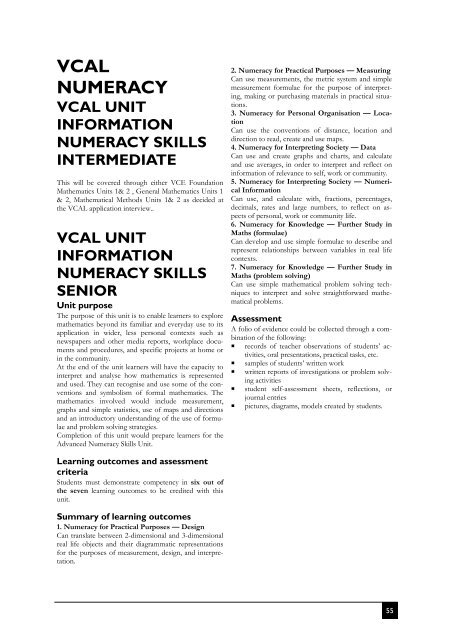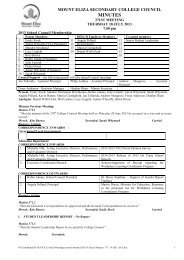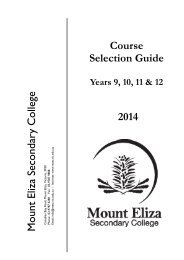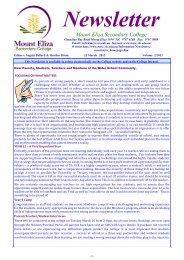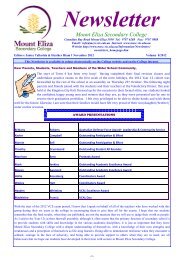senior school handbook 2008 - Mount Eliza Secondary College
senior school handbook 2008 - Mount Eliza Secondary College
senior school handbook 2008 - Mount Eliza Secondary College
You also want an ePaper? Increase the reach of your titles
YUMPU automatically turns print PDFs into web optimized ePapers that Google loves.
VCAL<br />
NUMERACY<br />
VCAL UNIT<br />
INFORMATION<br />
NUMERACY SKILLS<br />
INTERMEDIATE<br />
This will be covered through either VCE Foundation<br />
Mathematics Units 1& 2 , General Mathematics Units 1<br />
& 2, Mathematical Methods Units 1& 2 as decided at<br />
the VCAL application interview..<br />
VCAL UNIT<br />
INFORMATION<br />
NUMERACY SKILLS<br />
SENIOR<br />
Unit purpose<br />
The purpose of this unit is to enable learners to explore<br />
mathematics beyond its familiar and everyday use to its<br />
application in wider, less personal contexts such as<br />
newspapers and other media reports, workplace documents<br />
and procedures, and specific projects at home or<br />
in the community.<br />
At the end of the unit learners will have the capacity to<br />
interpret and analyse how mathematics is represented<br />
and used. They can recognise and use some of the conventions<br />
and symbolism of formal mathematics. The<br />
mathematics involved would include measurement,<br />
graphs and simple statistics, use of maps and directions<br />
and an introductory understanding of the use of formulae<br />
and problem solving strategies.<br />
Completion of this unit would prepare learners for the<br />
Advanced Numeracy Skills Unit.<br />
2. Numeracy for Practical Purposes — Measuring<br />
Can use measurements, the metric system and simple<br />
measurement formulae for the purpose of interpreting,<br />
making or purchasing materials in practical situations.<br />
3. Numeracy for Personal Organisation — Location<br />
Can use the conventions of distance, location and<br />
direction to read, create and use maps.<br />
4. Numeracy for Interpreting Society — Data<br />
Can use and create graphs and charts, and calculate<br />
and use averages, in order to interpret and reflect on<br />
information of relevance to self, work or community.<br />
5. Numeracy for Interpreting Society — Numerical<br />
Information<br />
Can use, and calculate with, fractions, percentages,<br />
decimals, rates and large numbers, to reflect on aspects<br />
of personal, work or community life.<br />
6. Numeracy for Knowledge — Further Study in<br />
Maths (formulae)<br />
Can develop and use simple formulae to describe and<br />
represent relationships between variables in real life<br />
contexts.<br />
7. Numeracy for Knowledge — Further Study in<br />
Maths (problem solving)<br />
Can use simple mathematical problem solving techniques<br />
to interpret and solve straightforward mathematical<br />
problems.<br />
Assessment<br />
A folio of evidence could be collected through a combination<br />
of the following:<br />
records of teacher observations of students’ activities,<br />
oral presentations, practical tasks, etc.<br />
samples of students’ written work<br />
written reports of investigations or problem solving<br />
activities<br />
student self-assessment sheets, reflections, or<br />
journal entries<br />
pictures, diagrams, models created by students.<br />
Learning outcomes and assessment<br />
criteria<br />
Students must demonstrate competency in six out of<br />
the seven learning outcomes to be credited with this<br />
unit.<br />
Summary of learning outcomes<br />
1. Numeracy for Practical Purposes — Design<br />
Can translate between 2-dimensional and 3-dimensional<br />
real life objects and their diagrammatic representations<br />
for the purposes of measurement, design, and interpretation.<br />
55


